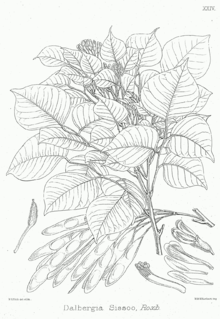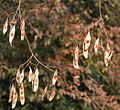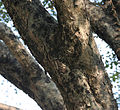- Dalbergia
-
Dalbergia 
Sissoo or Indian Rosewood (Dalbergia sissoo) Scientific classification Kingdom: Plantae (unranked): Angiosperms (unranked): Eudicots (unranked): Rosids Order: Fabales Family: Fabaceae Subfamily: Faboideae Tribe: Dalbergieae Genus: Dalbergia
L.f.[1]Species See text.
Synonyms Amerimnon P.Browne
Coroya Pierre
Ecastaphyllum P.Browne
Miscolobium Vogel
Triptolemea Mart.[1]Dalbergia is a large genus of small to medium-size trees, shrubs and lianas in the pea family, Fabaceae, subfamily Faboideae. The genus has a wide distribution, native to the tropical regions of Central and South America, Africa, Madagascar and southern Asia. The size of the genus is disputed, with different authorities citing between 100–600 species; ILDIS accepts 159 species.
Contents
Selected species
- Dalbergia bariensis Pierre – Burmese rosewood
- Dalbergia baronii Baker – Madagascar Rosewood, Palisander Rosewood, Palissandre Voamboana
- Dalbergia brownei (Jacq.) Schinz – Coin Vine
- Dalbergia cearensis Ducke – Kingwood
- Dalbergia cochinchinensis Laness. – Siamese Rosewood, Thailand Rosewood, Tracwood
- Dalbergia decipularis Rizzini & Matt. – Tulipwood
- Dalbergia ecastaphyllum (L.) Taub. – Coinvine
- Dalbergia frutescens (Vell.) Britton (Syn. Dalbergia variabilis) – Brazilian Tulipwood, Jacarandá Rosa, Pau de Fuso, Pau Rosa, Pinkwood, Tulipwood
- Dalbergia hupeana Hance
- Dalbergia latifolia Roxb. – Bombay Blackwood, East Indian Rosewood, Indian Palisandre, Indian Rosewood, Java Palisandre, Malabar, Sonokeling, Shisham, Sitsal, Satisal
- Dalbergia louvelii R.Vig.
- Dalbergia madagascariensis Vatke
- Dalbergia mammosa Pierre
- Dalbergia melanoxylon – African Blackwood, African Ebony, African Grenadilo, Banbanus, Ebene, Granadilla, Granadille d'Afrique, Mpingo, Pau Preto, Poyi, Zebrawood
- Dalbergia monetaria L.f. – Moneybush
- Dalbergia nigra (Vell.) Allemão ex Benth. – Bahia Rosewood, Brazilian Rosewood, Cabiuna, Caviuna, Jacarandá, Jacarandá De Brasil, Palisander, Palisandre da Brésil, Pianowood, Rio Rosewood, Rosewood, Obuina
- Dalbergia obovata E.Mey. - Climbing Flat Bean
- Dalbergia odorifera T.Chen. - Fragrant Rosewood
- Dalbergia palescrito Rzed. – Palo Escrito
- Dalbergia pinnata (Lour.) Prain
- Dalbergia retusa Hemsl. – Caviuna, Cocobolo, Cocobolo Prieto, Funeram, Granadillo, Jacarandáholz, Nambar, Nicaraguan Rosewood, Palisander, Palissandro, Palo Negro, Pau Preto, Rosewood, Urauna
- Dalbergia sissoo – Agara, Agaru, Errasissu, Gette, Hihu, Indian Rosewood, Iruvil, Iti, Khujrap, Padimi, Safedar, Sheesham, Shinshapa, Shisham, Shishma, Shishom, Sinsupa, Sissoo, Sisu, Tali, Tenach, Tukreekung, Yette
- Dalbergia stevensonii Standl. – Honduras Rosewood, Nogaed
- Dalbergia tonkinensis Prain
- Dalbergia tucurensis Donn.Sm. – Guatemalan Rosewood[2]
Formerly placed here
- Cladrastis delavayi (Franch.) Prain (as D. delavayi Franch.)
- Derris robusta (Roxb. ex DC.) Benth. (as D. robusta Roxb. ex DC.)
- Lonchocarpus heptaphyllus (Poir.) DC. (as D. heptaphylla Poir. or D. pentaphylla Poir.)
- Philenoptera nelsii (Schinz) Schrire (as D. nelsii Schinz)
- Pterocarpus rotundifolius (Sond.) Druce (as D. rotundifolia Sond.)[2]
Uses
Many species of Dalbergia are important timber trees, valued for their decorative and often fragrant wood, rich in aromatic oils. The most famous of these are the rosewoods, so-named because of the smell, but several other valuable woods are yielded by the genus.
The pre-eminent rosewood appreciated in the western world is D. nigra known as Rio, Bahia, Brazilian Rosewood, Palisander de Rio Grande, or Jacarandá; heavily exploited in the past, it is now listed on CITES Appendix I.[3] The second most desired rosewood in the western world is D. latifolia known as (East) Indian Rosewood or Sonokeling. Most rosewoods are a rich brown with a good figure. Note that only a small part of all Dalbergia species yield rosewood.
The (Brazilian) Tulipwood (D. decipularis) is cream coloured with red or salmon stripes. It is most often used in crossbanding and other veneers; it should not be confused with the "tulipwood" of the American Tulip Tree Liriodendron tulipifera, used in inexpensive cabinetwork.
The similarly used (but purple with darker stripes), and also Brazilian, Kingwood is yielded by D. cearensis. Both are smallish trees, to 10 m. Another notable timber is Cocobolo, mainly from D. retusa, a Central American timber with spectacular decorative orange red figure on freshly cut surfaces which quickly fades in air to more subdued tones and hues.
"Dalbergia sissoo" is primarily used for furniture in northern India. Its export is highly regulated due to recent high rates of death due to unknown causes. The Indian souvenir trade sells objects made of Dalbergia sissoo, which has historically been the primary rosewood species of northern India.
African Blackwood (D. melanoxylon) is an intensely black wood in demand for making woodwind musical instruments.
Dalbergia species are used as food plants by the larvae of some Lepidoptera species including Bucculatrix mendax which feeds exclusively on Dalbergia sissoo.
The Dalbergia species are notorious for causing allergic reactions due the presence of sensitizing quinones in the wood.
Gallery of Dalbergia lanceolaria
-
Leafless tree in Kolkata, West Bengal, India.
-
Leaves in Kolkata, West Bengal, India.
-
Dried Pods in Kolkata, West Bengal, India.
-
Trunk in Kolkata, West Bengal, India.
-
Pods in Kolkata, West Bengal, India.
-
Old trunk in Kolkata, West Bengal, India.
References
- ^ a b "Genus: Dalbergia L. f.". Germplasm Resources Information Network. United States Department of Agriculture. 2007-10-05. http://www.ars-grin.gov/cgi-bin/npgs/html/genus.pl?3367. Retrieved 2010-11-26.
- ^ a b "GRIN Species Records of Dalbergia". Germplasm Resources Information Network. United States Department of Agriculture. http://www.ars-grin.gov/cgi-bin/npgs/html/splist.pl?3367. Retrieved 2010-11-26.
- ^ "Appendices I, II and III". Convention on Trade in Endangered Species of Wild Flora and Fauna. 2010-10-14. http://www.cites.org/eng/app/appendices.shtml. Retrieved 2010-11-26.
Categories:
Wikimedia Foundation. 2010.







